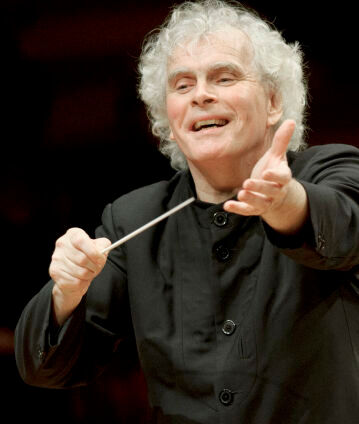Third concert in the Brahms/Schumann cycle with Simon Rattle

The third symphonies of Johannes Brahms and Robert Schumann which Simon Rattle conducts in this 2014 concert demonstrate that Romanticism was not only a period of reflection but also of confidence. The Brahms work, which was sometimes compared to Beethoven’s Eroica, comes across as powerful and optimistic, while Schumann’s Rhenish Symphony shows an unusually exuberant side of the composer.
Much has been speculated about possible influences on Johannes Brahms’s Third Symphony, composed in the summer of 1883. Similarities between the main theme of the first movement and two bridge passages in Schumann’s Symphonies No. 1 (2nd movement) and No. 3 (1st movement) have been pointed out, not that any relevant indications were made by Brahms or Clara Schumann. One thing is clear: Brahms’s symphony filled his contemporaries with enthusiasm. “What a work, what poetry, the most harmonious mood throughout the whole piece, all the movements as if cast from one mould, one heartbeat, every movement is a jewel! – How one is surrounded by the mysterious spell of forest life from the beginning to the end!” (Clara Schumann).
Robert Schumann’s “Third”– in chronological terms his Fourth – was a resounding success at its premiere on 6 February 1851. The stirring and singularly vital work was celebrated as “a piece of Rhenish life in refreshing cheerfulness,” whereby the music “particularly made a visible impression in the first two middle movements” and was “heard to enthusiastic applause” (Rheinische Musikzeitung). The work’s title is attributed to Wilhelm Josef von Wasielewski, concertmaster of the Düsseldorfer Symphoniker and later Schumann’s biographer: the composer was “first inspired” to create the work “by seeing Cologne cathedral”, which explains why it could be called “Rhenish”. Schumann was satisfied with his symphony: “Folk-like elements had to prevail here, and I believe I succeeded in doing so.”
© 2014 Berlin Phil Media GmbH
Related interviews
Artists
Our recommendations
- A magical Ravel concert with Simon Rattle
- 2013 New Year’s Eve Concert with Simon Rattle
- Simon Rattle conducts Beethoven’s Symphony No. 9
- Simon Rattle conducts Dvořák, Turnage and Brahms
- The 2011 New Year’s Eve Concert with Simon Rattle and Evgeny Kissin
- 2005 Europakonzert from Budapest with Simon Rattle and Leonidas Kavakos